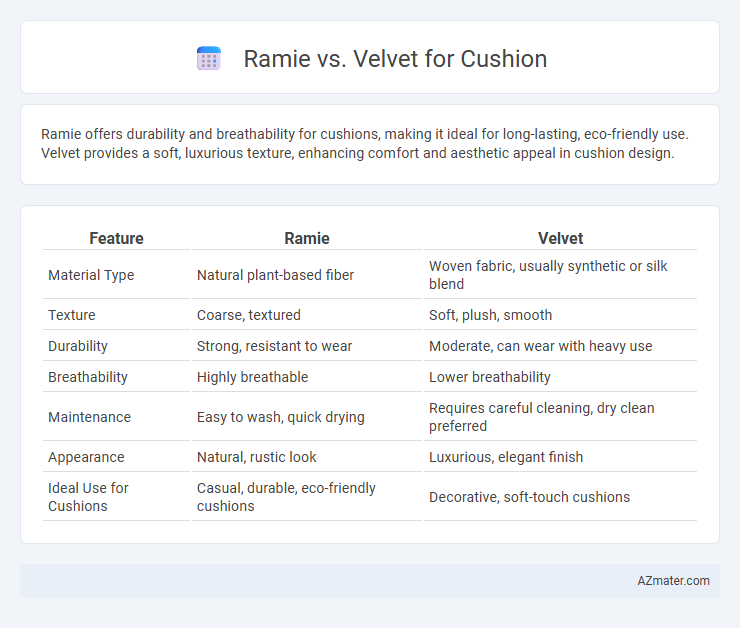Ramie offers durability and breathability for cushions, making it ideal for long-lasting, eco-friendly use. Velvet provides a soft, luxurious texture, enhancing comfort and aesthetic appeal in cushion design.
Table of Comparison
| Feature | Ramie | Velvet |
|---|---|---|
| Material Type | Natural plant-based fiber | Woven fabric, usually synthetic or silk blend |
| Texture | Coarse, textured | Soft, plush, smooth |
| Durability | Strong, resistant to wear | Moderate, can wear with heavy use |
| Breathability | Highly breathable | Lower breathability |
| Maintenance | Easy to wash, quick drying | Requires careful cleaning, dry clean preferred |
| Appearance | Natural, rustic look | Luxurious, elegant finish |
| Ideal Use for Cushions | Casual, durable, eco-friendly cushions | Decorative, soft-touch cushions |
Introduction to Ramie and Velvet Cushions
Ramie cushions are crafted from a natural fiber known for its durability, breathability, and resistance to wrinkles and mildew, making them ideal for both indoor and outdoor use. Velvet cushions, made from luxurious woven fabric with a soft pile, offer a plush, elegant appearance and a cozy texture that enhances comfort and aesthetic appeal. While ramie provides a rustic, natural look paired with resilience, velvet cushions contribute a sophisticated and velvety touch suitable for stylish indoor decor.
Origins and Production of Ramie vs Velvet
Ramie is a natural fiber derived from the stalks of the Chinese nettle plant, primarily cultivated in China, Brazil, and the Philippines, with its production involving retting, drying, and mechanical decortication to extract strong, lustrous fibers. Velvet, traditionally made from silk or cotton fibers, originated in medieval Europe and is produced through a weaving technique that creates its signature dense, soft pile by weaving two layers of fabric simultaneously. Ramie's renewable botanical origin and eco-friendly extraction contrast with velvet's complex weaving process, which varies depending on the fiber source, affecting durability and texture in cushion upholstery.
Texture and Feel: Ramie vs Velvet
Ramie fabric offers a coarse, natural texture with a slightly stiff feel that softens over multiple washes, ideal for cushions requiring durability and breathability. Velvet provides a smooth, plush texture with a luxurious, soft touch that enhances comfort and visual appeal in cushions. The choice between ramie and velvet hinges on desired tactile experience--rugged and breathable versus soft and elegant.
Durability and Longevity Comparison
Ramie fabric offers exceptional durability for cushions due to its strong natural fibers, resisting wear and tear better than many other materials. Velvet, while luxurious and soft, tends to show signs of wear more quickly, such as crushing and pilling, which can reduce its longevity on frequently used cushions. Cushions made with ramie are ideal for long-term use in high-traffic areas, while velvet suits decorative cushions with less intensive use.
Maintenance and Cleaning Requirements
Ramie cushions require gentle hand washing or dry cleaning to preserve fiber integrity, as their natural cellulose fibers are prone to shrinkage and damage from harsh detergents. Velvet cushions demand careful spot cleaning with a mild detergent and sometimes professional cleaning due to their dense pile and susceptibility to crushing or matting. Both materials benefit from regular vacuuming to remove dust, but velvet cushions require more delicate handling to maintain their luxurious texture over time.
Style and Aesthetic Appeal
Ramie fabric offers a natural, textured look with a matte finish that adds a rustic, organic charm to cushions, making it ideal for farmhouse or bohemian styles. Velvet provides a luxurious, smooth surface with a rich sheen that enhances cushions with a sophisticated and elegant aesthetic, perfect for traditional or modern glam interiors. Both materials bring distinct visual appeal, with ramie delivering warmth and earthiness, while velvet contributes depth and opulence.
Comfort Levels: Which Is Softer?
Velvet offers a plush, dense pile that provides a luxuriously soft and smooth texture, making it ideal for cushions where comfort is a priority. Ramie, a natural fiber known for its durability, has a coarser feel and is less soft than velvet, resulting in a more firm cushion surface. For superior comfort and softness in cushions, velvet significantly outperforms ramie in tactile experience.
Eco-Friendliness and Sustainability
Ramie fiber is highly eco-friendly due to its natural biodegradability and minimal need for pesticides or fertilizers, making it a sustainable choice for cushions. Velvet, often made from synthetic fibers or cotton, typically involves more resource-intensive production processes and less environmental biodegradation. Choosing ramie over velvet reduces ecological impact and supports sustainable textile practices in home decor.
Price and Value Analysis
Ramie cushions typically offer a lower price point due to the natural fiber's abundance and durability, making them a cost-effective choice for budget-conscious buyers. Velvet cushions, while more expensive, provide superior softness, luxurious texture, and a high-end aesthetic that justifies the premium cost in terms of value and comfort. Evaluating cushions based on durability, feel, and price, ramie is ideal for practical use, whereas velvet excels in adding elegant appeal and tactile richness to living spaces.
Which Fabric is Best for Your Cushions?
Ramie fabric offers exceptional durability and breathability, making it ideal for cushions in warm or humid environments due to its natural moisture-wicking properties. Velvet provides a plush, luxurious feel with a soft texture that elevates aesthetic appeal but requires more maintenance and is less resistant to wear and moisture. Choosing between ramie and velvet depends on whether longevity and ventilation or softness and elegance are prioritized for your cushions.

Infographic: Ramie vs Velvet for Cushion
 azmater.com
azmater.com